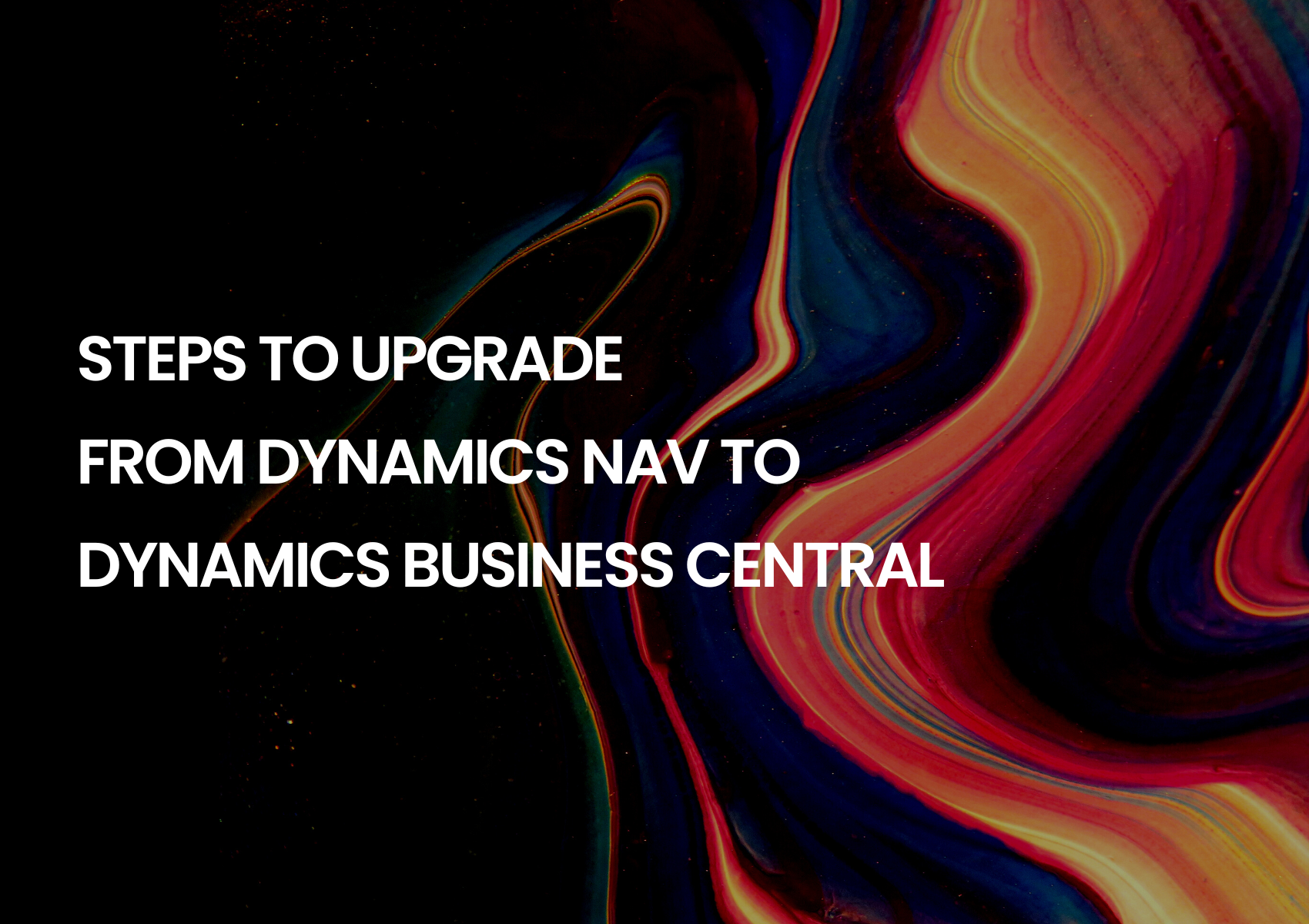Blog
How Can Dynamics NAV Users Upgrade to Business Central in 2023?

Microsoft Dynamics NAV, an on-premise ERP that aids businesses in managing enterprise-wide systems and procedures, is being phased out. Microsoft advises upgrading to Dynamics Business Central for current Dynamics NAV users. Let’s first comprehend Dynamics Business Central for a better understanding.
As per a report by Forrester, a modern business management tool, Dynamics Business Central, enables organizations to integrate all their operations onto a single platform.
The Business Central on-premise or cloud-based versions are available to businesses for a more innovative way of working. Before we get to know more about how to upgrade Dynamics NAV to Business Central, let’s learn more about BC and the benefits of Dynamics NAV upgrade.
What is Dynamics 365 Business Central?
Dynamics Business Central is a cloud-based enterprise resource planning (ERP) solution developed by Microsoft. It provides small and medium-sized businesses with comprehensive financial and supply chain management capabilities.
Business Central is built on the Dynamics 365 platform and integrates with other Microsoft products, such as Office 365, Power Platform, and Power BI, providing a seamless and integrated experience. Its development platform also offers robust customization and extension capabilities, allowing businesses to tailor the solution to meet their specific needs.
The solution is designed to be flexible and scalable, making it suitable for organizations of all sizes. With its cloud-based delivery model, Business Central can be accessed from anywhere, on any device, giving businesses real-time visibility into their operations and enabling them to make informed decisions quickly and easily.
How is Microsoft NAV Different than Dynamics Business Central?
Microsoft Dynamics Business Central and Microsoft Dynamics NAV are both enterprise resource planning (ERP) solutions offered by Microsoft, but there are key differences between them:
Deployment
Dynamics Business Central is a cloud-based solution, while Dynamics NAV is an on-premise solution. With Dynamics 365, businesses can access their data and applications from anywhere with an internet connection, while with Dynamics NAV, businesses must host their data and applications on their servers.
Scalability
Dynamics Business Central is a highly scalable solution that can accommodate the changing needs of growing businesses, while Dynamics NAV is designed for smaller, more specialized organizations.
Functionality
Dynamics Business Central provides more comprehensive functionality, including customer relationship management (CRM), project management, and business intelligence. In contrast, Dynamics NAV provides a more focused functionality, including financial management, supply chain management, and procurement.
User experience
Business Central offers a more modern and intuitive user interface, while Dynamics NAV has a more traditional and functional interface.
Integration
Dynamics Business Central integrates with other Microsoft solutions, such as PowerApps, PowerBI, and Microsoft Teams. On the other hand, Dynamics NAV has limited integration capabilities.
Cost
Business Central is typically more expensive than Dynamics NAV due to its cloud-based deployment model and broader set of functionality.
All in all, Business Central and NAV have their strengths and weaknesses, and the choice will depend on each business’s specific needs and requirements. BC is better for larger, more complex organizations that require a comprehensive business management solution. In comparison, Dynamics NAV is a better choice for smaller, more specialized organizations that require a more focused set of functionality.
Why Should You Upgrade Dynamics NAV to Business Central?
There are several reasons why organizations may choose to upgrade from Dynamics NAV to Dynamics 365 Business Central:
- Improved functionality: Dynamics Business Central offers enhanced functionalities and features, such as advanced financial management, not available in earlier versions of Dynamics NAV.
- Better user experience: Business Central has a modern and user-friendly interface, making it easier for users to access and manage data.
- Integration with other Microsoft products: Business Central integrates with other Microsoft products, such as Office 365, Power Platform, and Power Apps, making it easier for organizations to automate and streamline business processes.
- Increased efficiency: With Dynamics Business Central, organizations can automate many manual processes and work more efficiently, reducing the risk of errors and increasing productivity.
- Access to the latest technology: Upgrading Dynamics NAV to Business Central ensures that organizations have access to the latest technology and advancements in enterprise resource planning (ERP).
- Flexibility and scalability: Dynamics Business Central is a cloud-based solution that allows organizations to access their data from anywhere and scale their system as their business grows.
What are the Steps to Upgrade from Dynamics NAV to Business Central?
To upgrade Dynamics NAV to Business Central, you will need to follow these steps:
- Preparation: Ensure that your current Dynamics NAV environment meets the minimum requirements for upgrading and backing your data.
- Review the upgrade path: Determine the upgrade path based on the version of Dynamics NAV you are currently running and the version you want to upgrade to.
- Install the new version of Dynamics NAV: Install the new version of Dynamics NAV on the server and configure it for use.
- Convert data: Convert your existing data to the new version format. This can be done using the built-in or third-party conversion tool if available.
- Customization review: Review any customizations made to your current Dynamics NAV system to ensure they will work with the new version.
- Test the upgrade: Thoroughly test the upgraded system to ensure that all customizations and data have been upgraded and that the system is working as expected.
- Go live: After complete testing, you can go live with the new version of Dynamics NAV.
It is recommended to involve a Microsoft Gold partner or professional to assist in the Dynamics NAV upgrade process to minimize the risk of errors and ensure a smooth transition to the new version.
To Sum Up
Microsoft has announced that Dynamics NAV users will be able to upgrade to Business Central in 2023. This upgrade will give Dynamics NAV customers access to the latest features and tools available in Business Central, including improved analytics, enhanced reporting, and more user-friendly navigation.
Furthermore, the upgrade will bring Dynamics NAV customers into the cloud, providing them with improved system performance, scalability, and security. As part of the upgrade process, Dynamics NAV customers will need to migrate their data and customizations to the cloud-based Business Central platform. They should consider the time and resources needed for this process before beginning.
If you want to go through a seamless Dynamics NAV upgrade, hire our skilled team, DynamicsSmartz, a Microsoft Gold Partner.
Categories
- Upgrade
- United States
- United Arab Emirates
- Power BI
- Power Automate
- Partner Program
- Office 365
- Migration
- Industry Updates And Events
- Implementation
- Dynamics SL
- Dynamics NAV
- Dynamics GP
- Dynamics Business Central
- Dynamics 365 for Sales
- Dynamics 365 Field Service
- Dynamics 365
- CRM and ERP
- Construction365
- Australia
- Artificial Intelligence
Recent Posts
- Microsoft Dynamics 365: The Backbone of Australia’s Finance and Supply Chain Excellence
- Copilot AI for Different Industries in D365 (2025 Update): Transforming Future
- Microsoft Dynamics 365 vs Power Apps: A Fresh Comparison for 2025
- Why Sales Processes Matter in Dynamics 365 CRM
- Dynamics 365 Sales vs Customer Service: What are the key differences?








